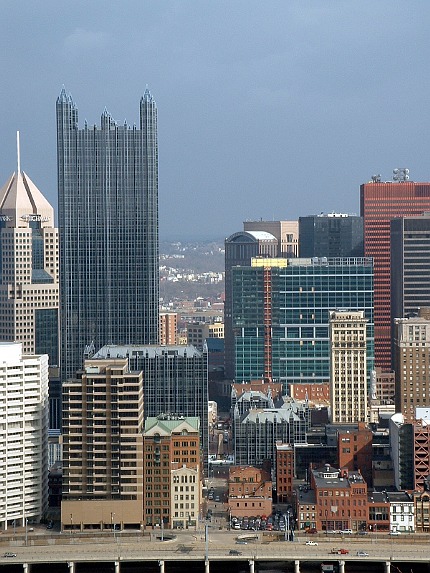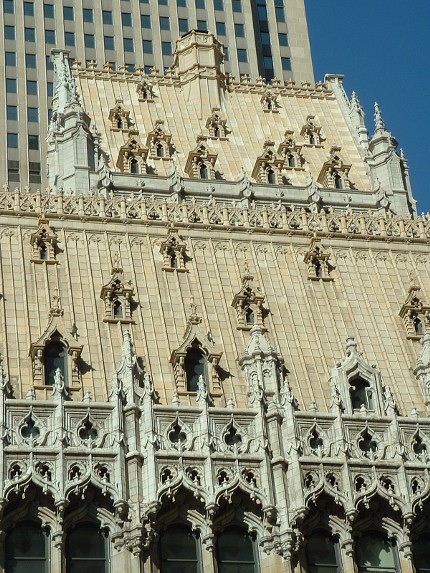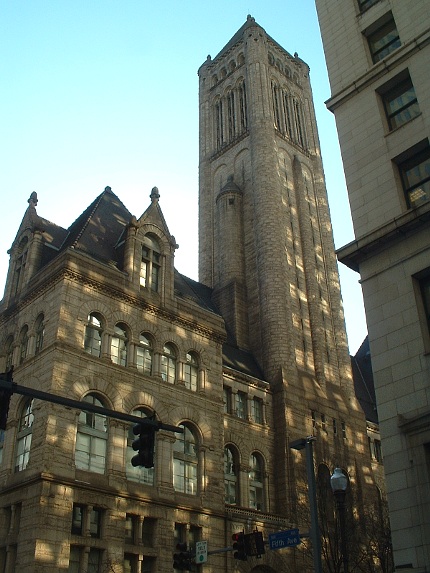
Slices of the skyline of downtown Pittsburgh, with every kind of stone, brick, steel, and glass glimmering in the noonday sun.


The entrances to a pair of 1880 rowhouses on Grandview Avenue, showing all the fun you can have with wood in even so simple a structure as a porch roof.


This wonderfully ornate protrusion on the roof of the Union Trust Building, the masterpiece of Frederick Osterling, has given rise to the urban legend that there is a secret chapel on the roof, where perhaps Henry Clay Frick himself went to repent of his many sins. The truth is more prosaic and yet more impressive as an architectural accomplishment: the chapel-like structure houses the mechanics for the elevators and other necessities that normally make ugly blisters on the roofs of large buildings.
The Union Trust Building is just across the street from the Grant Street exit of the Steel Plaza subway station.

A winter morning’s sunlight, reflected from the windows of the Frick Building, paints the tower of the Allegheny County Courthouse with stripes of gold. Henry Hobson Richardson, one of America’s greatest architects, considered this his masterpiece, though he did not live to see it completed. Philip Johnson, whose PPG Place has become the iconic symbol of the Pittsburgh skyline, called the Courthouse the best building in America.
If imitation is the sincerest form of flattery, then this is an unusually well-flattered building: the city hall of Minneapolis is an acknowledged copy of it. It is not unusual for an architect to copy a famous classical or medieval building, but quite rare to copy one that was only a quarter-century old at the time. Such was Richardson’s reputation that Long and Kees, architects of the Minneapolis City Hall, were willing to pay this ultimate tribute to their master in what is widely considered their own masterpiecce.
The Courthouse is half a block south on Grant Street from the Grant Street exit of the Steel Plaza subway station.

The store is called Macy’s now, but you’ll hardly find a real Yinzer who can bring himself to call it that. It will always be Kaufmann’s, the biggest department store in Pittsburgh, taking up a whole city block and slopping over into the next. With a dozen floors of retail space, it’s still bigger than some whole suburban shopping malls.
This clock, at the corner of Fifth and Smithfield, is Pittsburgh’s legendary meeting place. It can still get crowded underneath with people who’ve promised to wait for someone “under the Kaufmann’s clock.” And it’s always working, which is a boon for people who, like old Pa Pitt, often forget to stuff their watches into their pockets in the morning.
Macy’s is a short stroll from the Grant Street exit of the Steel Plaza subway station.
Father Pitt has learned that the city of Phoenix in Arizona, a largely mythological state, has just begun to enjoy the many benefits of a modern light-rail transit system—or, to use a better and more descriptive term, streetcars. Seeing that cheering news, old Pa Pitt tried to remember how long Pittsburgh has had light-rail transit. After jogging his memory, he came up with an answer: exactly 150 years. The first streetcar tracks were laid in 1859.
One hundred fifty years of streetcars! This seems like a momentous occasion, an anniversary to celebrate with fireworks and cake. Those first cars were drawn by horses, of course. After them came cable cars, much like the ones in San Francisco. They lasted only a short time before they were replaced by electric traction, which is what we still use today.
Many things have changed since then. Much of the street trackage has been replaced by buses, although streetcars still run on the street in Allentown and Beechview. In the 1980s, the streetcars downtown finally moved into the subway that Pittsburghers had been clamoring for since the turn of the twentieth century or before. But “light rail” service in one form or another has been continuous since before the Civil War, which is an enviable record few American cities can match. Here is a wonderful collection of pictures of Pittsburgh streetcars, mostly from the PCC era.
So to the citizens of Phoenix, Father Pitt sends his warmest greetings: Welcome to the mechanical age! Based on his experience over the last century and a half, Pa Pitt thinks you’re going to like it here.
The streetcar lines from the South Hills all converge downtown and go into a clean and pleasant subway. Steel Plaza station, shown here, is where the short line to Penn Station (served only in rush hour) branches off the main line. Here a not-in-service car from Penn Station sits at the platform waiting for its next assignment.

Update: The Highland Building has been expensively restored and looks beautiful.
Daniel Burnham designed many of the most distinguished buildings downtown. East Liberty, which once called itself the “second downtown,” is the only other neighborhood in the city with a Burnham building. It’s far from his biggest work in Pittsburgh, but the Highland Building is an elegant design that has been left shamefully derelict. Now that East Liberty is rapidly reviving, there are plans for a luxury hotel here, which would be a fine second use for a building that desperately needs to be loved.
Like everything else in the central business district of East Liberty, the Highland Building is a short walk from the East Liberty Station on the East Busway.


Franklin Toker, the architectural historian, says this may be, per square foot, the most expensive church ever built in America. Ralph Adams Cram (who may have been America’s greatest Gothic architect) designed it, and it was built with enormous donations of Mellon money, which is why locals know it as the Mellon Fire Escape. It dominates East Liberty from every angle. Above, a view from the south over the rooftops of East Liberty; below, the great central tower.
